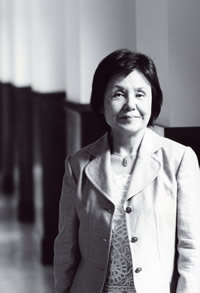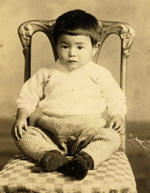 |
| What I told a math teacher |
 |
 |
When I was in primary school, a teacher showed me how to raise cabbage butterflies. I developed a passion for it, and my home became filled with caterpillars, even when I was evacuated from the city during the war. During my years in junior high school and high school, knowledgeable older students taught me the basics of natural sciences. I preferred raising butterflies to collecting rare specimens. That was my own way of coming in contact with living creatures.
I intended to go to Kyoto University’s School of Agriculture and become an entomologist, but during a school trip we stopped by Akamon and Sanshiro Pond. They left an impression on me, so I went to the University of Tokyo instead. One of my classmates was Ken’ichi Matsubara, a professor emeritus at Osaka University and the president of DNA Chip Research Inc. We were kindred spirits with an interest in pursing studies in biology. I couldn’t stand chemistry, and had to take makeup tests, but in one course, I learned that biochemistry studied the connection between living creatures and substances. I then sensed a fresh appeal in the subject, and switched my major to chemistry. |
 |
The physical chemistry and evolutionary studies
related to proteins |
 |
 |
Prof. Osawa places great emphasis on both theory and experiments. When I honestly admitted that I was poor at experiments, he introduced me to a professor of statistical mechanics at Waseda University. I developed a method for statistically determining the three-dimensional structure that could be assumed by nucleic acid in a solution, which won acclaim in physical chemistry fields.
I wanted to do something that was more oriented toward biology, however, so I thought of further investigating proteins, which are the molecules of a living organism, and which have diverse structures. The interests of my husband (Nobuhiro Go, currently with the Japan Atomic Energy Agency and a visiting professor at the Nara Institute of Science and Technology) also changed from theoretical physics to biophysics. We went to study at the laboratory of Professor Harold Scheraga at Cornell University, a pioneer in the study of the physical chemistry of proteins. We began joint research by utilizing both of our fields of specialty, and calculated in a model the three-dimensional structure of an artificial macromolecule linked by a single amino acid. We wrote a paper together in English under all three of our names, and Prof. Scheraga was amused by the resulting credit to Go, Go, Scheraga.
We continued that work for a while after returning to Japan, but then I began to be interested in examining proteins as a product of evolution, and not merely their physical and chemical characteristics. This new aspect made proteins seem like a living organism. I also decided that it was not advisable for a husband and wife to be forever interested in the same subject.
At just that time, a new mathematical biology course was established at Kyushu University. I was given responsibility for the field of the molecular evolution of proteins, with Prof. Hirotsugu Matsuda (now professor emeritus) taking charge of population genetics and Associate Prof. Takashi Miyata (now an advisor at the JT Biohistory Research Hall) handing the molecular evolution of DNA. |
The genes of a eukaryote are comprised of an exon, which contains the protein information, and an intron, which links the exons. It was theorized that exons are the remnants of smaller genes of the past, and that proteins spliced together the pieces. At the time, this was just thought to be a hypothesis with no grounds for proof.
For me, however, who had only seen a single mass of protein, the theory that they were actually divided up into portions was appealing. I studied the positional relationship in space of the amino acids that made up hemoglobin at a particular time, and paid particular attention to amino acid pairs that were at a distance from each other. The portions that did not include these pairs were a concentration of amino acids in close spatial proximity. They conformed to the area constricted by the introns. I thought that this area was the unit that created the three-dimensional structure, and named it a module. It was thought that proteins evolved through the combination of these modules.
This idea was not well received initially, but after I went to Nagoya University, I verified using the techniques of physical chemistry that modules were singular, had a three-dimensional structure, and had a function. If proteins could be seen as substances that conformed to the laws of physics and chemistry, they also could be seen as a phenomenon that resembled living organisms. Having one foot in both camps was my own concept of biophysics. |

This graph, called the Go Plot, identifies the response of intron and the three-dimensional structure of proteins.
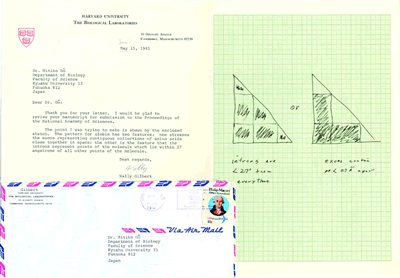
I sent a draft of my paper to Dr. Gilbert, winner of a Nobel Prize in chemistry and the discoverer of DNA sequencing. He had predicted that exons were functional units. He was surprised at the content, and sent me a polite reply with his own illustrations asking for an explication of the graph.
|
 |
| A new view of life shown by proteins |
 |
 |
|
I returned to biology, and correlated genome information with the data for the three-dimensional structure of proteins. I had thought exons were rather ordinary, but they were adaptable, because they behaved as introns and created a diversity of proteins. I had thought that the evolution of proteins was a process that created convenient substances and discarded those that were unacceptable, but perhaps those that seemed unacceptable at a glance were actively used for other purposes. As I observed proteins the substance, a new view of life that was not mechanistic emerged. |
|
The history of Ochanomizu University dates back 130 years. Once a week I bring a computer into the old president’s office, which I call my annex, and become engrossed in research. |
|
 |
 |
 I entered Ochanomizu University as a student in the Faculty of Science. Here I am in the middle of a physics experiment.
With a stuffed animal that I loved. I took it with me when I went to an American university to study. I entered Ochanomizu University as a student in the Faculty of Science. Here I am in the middle of a physics experiment.
With a stuffed animal that I loved. I took it with me when I went to an American university to study.
|
 |
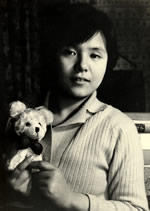 |
 Entranced by biophysics, I entered graduate school at Nagoya University in 1962. (Second from left in front row) Entranced by biophysics, I entered graduate school at Nagoya University in 1962. (Second from left in front row) |
 |
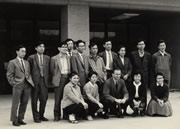 |
 Prof. Fumio Osawa (currently professor emeritus) is fourth from the right in the back row. Prof. Fumio Osawa (currently professor emeritus) is fourth from the right in the back row. |
 |
 |
 In front of the Yukawa Institute for Theoretical Physics, where I wanted to work In front of the Yukawa Institute for Theoretical Physics, where I wanted to work |
 |
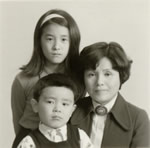 |
 |
 Passport photograph / Elder daughter (9) and elder son (4) Passport photograph / Elder daughter (9) and elder son (4) |
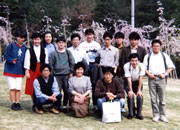 |
 A flower viewing party with members of the lab at Nagoya University
I am the second from left in the front row. On the right is Kenichi Takahashi, currently associate professor at the Nagahama Institute of Bio-Science and Technology. On the right end of the front row is Kei Yura of the Japan Atomic Energy Agency. On the right end of the back row is Tsuyoshi Shirai, currently associate professor at the Nagahama Institute of Bio-Science and Technology. Third from the left in the back row is Kaoru Fukami-Kobayashi, currently of RIKEN. A flower viewing party with members of the lab at Nagoya University
I am the second from left in the front row. On the right is Kenichi Takahashi, currently associate professor at the Nagahama Institute of Bio-Science and Technology. On the right end of the front row is Kei Yura of the Japan Atomic Energy Agency. On the right end of the back row is Tsuyoshi Shirai, currently associate professor at the Nagahama Institute of Bio-Science and Technology. Third from the left in the back row is Kaoru Fukami-Kobayashi, currently of RIKEN.
|
 |
 |
 At the lecture commemorating the retirement of Dr. Gilbert from Harvard University At the lecture commemorating the retirement of Dr. Gilbert from Harvard University |
 |
 |
 I served as a judge for the awards in the L’Oreal-UNESCO “For Women in Science” program. A winner of a prize in 2005 was Fumiko Yonezawa, professor emeritus at Keio University. I served as a judge for the awards in the L’Oreal-UNESCO “For Women in Science” program. A winner of a prize in 2005 was Fumiko Yonezawa, professor emeritus at Keio University. |
 |
 |
 A lab meeting at the Nagahama Institute of Bio-Science and Technology A lab meeting at the Nagahama Institute of Bio-Science and Technology |
|
